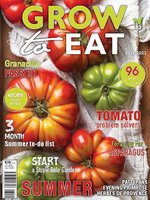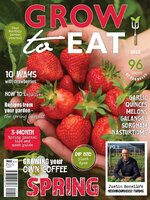Grow to Eat is the definitive seasonal guide to edible gardening in South Africa, brought to you by your favourite gardening magazine, The Gardener. A practical, non-nonsense guide, Grow to Eat is filled with growing, harvesting and cooking tips for seasonal fruit, vegetable and herbs.
Welcome
Grow to Eat
Essential Garden Goodies
A productive paradise at Angala • A new addition to Angala’s garden in Franschhoek makes for a highly productive space where guests and staff can revel in a treasure trove of fresh herbs, fruit and veggies.
Subscribe and win! • Stand a chance of winning a GARDENA PIPELINE READY-TO-GO SET when you subscribe to Grow to Eat Magazine
Potted veggie garden • You can still have a proper veggie garden in containers if you have limited space.
FLU Busters • In this article, Jane Griffiths shares tips on growing and using herbal remedies to avoid dreaded winter lurgies.
HOW TO GET flavour • INTO YOUR WINTER SOUPS AND DISHES
The lemon with the rosy heart • There is a new lemon on the market, and it’s making waves.
Citrus BODY BLISS • Pamper yourself this season with the healing benefits of citrus.
Psylla control on citrus • One of the most destructive pests we have on citrus trees is psylla.
Divine fruit of the Greeks
Start an organic vegetable garden – it’s always exciting!
How to grow macadamia nuts • Did you know that macadamia nuts are one of the healthiest nuts you can grow?
How to keep microbes thriving • Gardening is more about growing microbes than it is about growing plants.
Cactus PEAR • Spineless cactus pears are extremely versatile, drought- and heat-resistant succulents with huge potential for farmers and home growers.
The top 3 hacks to guarantee successful seed sowing
Exploring ASIAN MICROGREENS • If you have little time and space, microgreens are a good way to get your greens into your diet. In fact, most microgreens are more nutritious than their adult versions, making them an excellent choice for a healthy diet.
Growing fennel for flavour • Fennel is a lovely crunchy salad ingredient in summer and a nutritious, tasty ingredient roasted and in soups for winter.
Colourful Sage • Common sage (Salvia officinalis) is an age-old culinary and healing herb. Its soft, silvery leaves belie its tough, waterwise nature, and every plant should come with a warning: Don’t overwater!
Adapting to Climate change • ROAD MAP FOR THE NEXT FEW YEARS
Creating a Sustainable Haven • Let’s find out how we can best harness the power of supporting perennials.
How to make leaf mould • Leaf mould is formed when leaves decay and break down. Why you want to make it is because it’s a good soil conditioner and you can make it for free with fallen leaves from your garden.
What to do in April
What to do in May • Weeds grow enthusiastically in all seasons; the last thing you want is unwanted weeds smothering and competing with your growing food garden.
What to do in June • All crops that are vulnerable to cold and frost damage, should be protected with frost cloth overhead and a thick layer of mulch at soil level.
What to do in July • So many good things from the garden and kitchen go to waste. Simply recycling ‘green waste’ into compost saves you money and turns your garden soil into a powerhouse for growing healthy plants. No garden is too small for making compost…
What to do in August • If you are just itching to start sowing summer crops like tomatoes and chillies, follow these early sowing tips…
5 Garden hacks (that actually work)

 Autumn/Winter 2025 - April
Autumn/Winter 2025 - April
 Spring / Summer 2024
Spring / Summer 2024
 Summer 2023/2024
Summer 2023/2024
 Spring 2023
Spring 2023
 Autumn/Winter 2023
Autumn/Winter 2023
 Summer 2022/2023
Summer 2022/2023
 Spring 2022
Spring 2022
 Autumn/Winter 2022
Autumn/Winter 2022